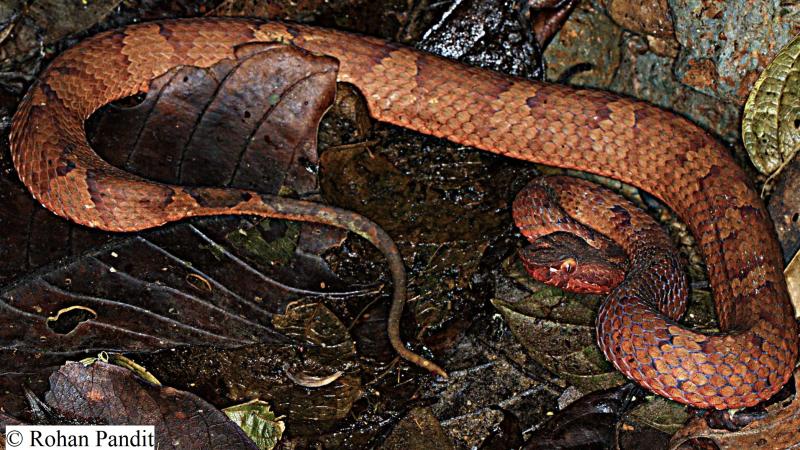
If you were to play a game of hide-and-seek with the recently discovered pitviper, Trimeresurus arunachalensis, there’s no questioning who would win! It's russet tones match the forest floor so well that you could walk right past it several times and be none the wiser. It is no surprise that researchers have described this elusive, yet memorable, species from a single known specimen, making it currently the rarest pitviper in the world.
The new species was discovered when a young herpetologist—Rohan Pandit and his field assistant Wangchu Phiang of the Eaglenest Biodiversity Project, were surveying the remote montane forests of West Kameng, Arunachal Pradesh. They spotted this snake, which was visually distinct from the other brown pitvipers, like the Mountain pitviper (Ovophis monticola) and the Brown spotted pitviper (Protobothrops mucrosquamatus), seen in this region. Closer examination confirmed that Trimeresurus arunachalensis was indeed a never-before-described species. The description of this new species was published in the Russian Journal of Herpetology.
Vipers are venomous snakes with long, hinged fangs that can penetrate deep into a hapless prey and deliver a lethal dose of venom. Pitvipers belong to the viper subfamily Crotalinae, and have heat-sensing pits on either sides of their head, between the eye and the nostril. These loreal pits act as a 'sixth' sense, allowing the snake to find, and even judge the size of small, warm-blooded prey. The organs may also give them an edge at night by helping them avoid predators.
Trimeresurus is the most diverse genus of pitvipers; there are about 50 known species distributed across the south and south-eastern parts of Asia. The addition of T. arunachalensis brings the number of pitvipers in India up to 24. The northeastern reaches of India are a treasure trove of undiscovered species and have unearthed several discoveries over the last two decades.

Image: The Arunachal Pitviper—Trimeresurus arunachalensis
"This discovery of a new species from Arunachal Pradesh, the latest in a list which has continued to grow even in the 21st century and includes mammals and birds, points to the biodiversity wealth of Arunachal Pradesh.” says an enthused Ashok Captain, who has been studying the snakes of Arunachal Pradesh since 1996.
This reddish-brown pitviper has a slender body and a broad neck. Its snout appears round when viewed from above, but is seen to project sharply above the lower jaw when viewed from the side. The head is a uniform shade of brown that matches the ground colour of its body. The body on the other hand, is a tapestry of brown blotches with irregular dark margins that zig-zag down its length. A broken white stripe runs along the sides of its belly scales. In addition to comparing its scalation with that of other pitvipers, the researchers sequenced its DNA and looked at its phylogeny—the evolution and diversification of this species to describe the pitviper as a new species.
The snake’s natural history is largely a mystery, its blotchy brown colour pattern and ability to merge with the forest floor suggests that it might be terrestrial. Since this species was described from just a single specimen, not much is known about its range and further research is required. Dr Bharat Bhatt, a scientist of the Arunachal Pradesh Forest Department and a co-author, stated that this was the first new species of pitviper to be discovered in India after a gap of 70 years.
The researchers suggest that the snake be called the Arunachal pitviper, after the state where it was discovered. This makes Arunachal the only Indian state to have a pitviper named after it!
Biodiversity surveys in the Northeast, like the one that helped discover the Arunachal pitviper, are key to discovering the mysteries that this area holds. The Eaglenest Biodiversity Project, spearheaded by Dr Ramana Athreya from IISER Pune, started in 2003 and is almost two decades old. Funded by the Rufford Foundation and the Ford Foundation, the survey aims at recording the birds, butterflies, reptiles and amphibians of this region, thereby raising awareness about its ecological wealth and potential for ecotourism.
However, tourism is a double-edged sword. On the one hand, it could lead to animal abuse and sensationalization. When done right, ecotourism, which is directed towards exotic and often threatened, natural environments with the intention of supporting conservation efforts, has helped boost the economy of the Bugun community, an indigenous tribe in Arunachal Pradesh and help fund future research.
This article has been run past the researchers, whose work is covered, to ensure accuracy.





